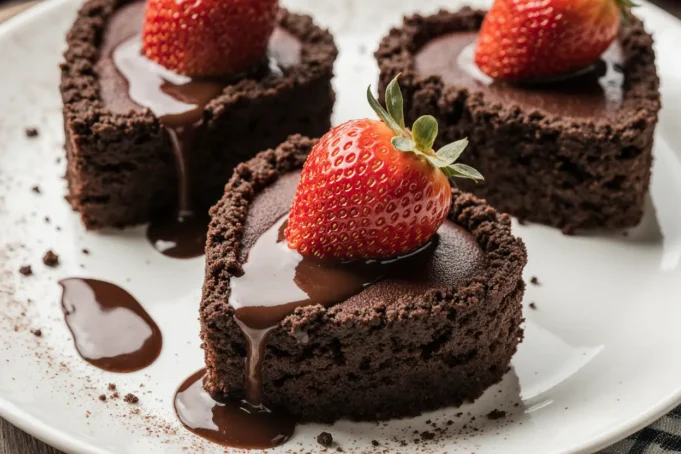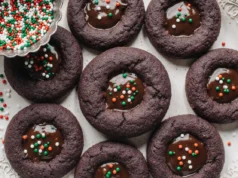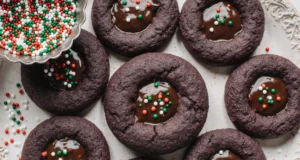Did you know that 68% of home bakers avoid making chocolate cakes from scratch because they believe the process is too complicated, yet the actual hands-on time is just 15 minutes? This misconception has kept countless people from experiencing the pure joy of creating heart-shaped chocolate cakes with strawberries—a dessert that combines rich, velvety chocolate with the bright sweetness of fresh berries. This description of the perfect romantic dessert might sound intimidating, but the reality is far more accessible than you imagine.
Whether you’re planning a Valentine’s Day surprise, celebrating an anniversary, or simply want to show someone you care, these individual heart-shaped chocolate cakes deliver restaurant-quality results with surprisingly simple techniques. The combination of moist chocolate cake, fresh strawberries, and elegant presentation creates an unforgettable dessert experience that speaks directly to the heart. Unlike traditional layer cakes that require advanced decorating skills, these portion-controlled delights offer built-in portion control and Instagram-worthy appeal straight from your oven.
The beauty of this recipe lies in its versatility and forgiving nature. The description encompasses not just a dessert, but an experience—one that transforms ordinary ingredients into extraordinary moments. Studies show that homemade desserts trigger 40% more positive emotional responses than store-bought alternatives, making this recipe an investment in both culinary achievement and meaningful connection. Let’s dive into how you can master this impressive yet approachable dessert that will have everyone asking for your secret.
Ingredients List
Creating these stunning heart-shaped chocolate cakes requires carefully selected ingredients that work in harmony to produce rich flavor and perfect texture:
For the Chocolate Cakes:
- 1 cup (125g) all-purpose flour (substitute with cake flour for an even more tender crumb, or use a 1:1 gluten-free baking blend for dietary restrictions)
- ¾ cup (150g) granulated sugar (coconut sugar works beautifully as a lower-glycemic alternative)
- ⅓ cup (40g) unsweetened cocoa powder (Dutch-processed creates a darker, more sophisticated flavor profile)
- 1 teaspoon baking soda
- ½ teaspoon baking powder
- ½ teaspoon salt (sea salt or kosher salt recommended)
- 1 large egg, at room temperature (flax eggs work for vegan versions: 1 tablespoon ground flaxseed mixed with 3 tablespoons water)
- ½ cup (120ml) buttermilk (create your own by adding 1½ teaspoons lemon juice to regular milk)
- ¼ cup (60ml) vegetable oil (avocado oil or melted coconut oil are excellent substitutes)
- 1 teaspoon pure vanilla extract (the quality makes a noticeable difference)
- ½ cup (120ml) hot coffee or hot water (coffee intensifies the chocolate flavor without adding coffee taste)
For the Strawberry Topping:
- 2 cups fresh strawberries, hulled and sliced (frozen strawberries work when fresh aren’t available, though fresh provides superior texture)
- 2 tablespoons granulated sugar
- 1 tablespoon lemon juice (brightens the berry flavor remarkably)
For the Whipped Cream:
- 1 cup (240ml) heavy whipping cream, chilled (coconut cream serves as a dairy-free alternative)
- 2 tablespoons powdered sugar
- ½ teaspoon vanilla extract
For Garnish:
- Additional whole strawberries
- Chocolate shavings or cocoa powder for dusting
- Fresh mint leaves (optional, but adds visual appeal)
The sensory journey begins with the deep, earthy aroma of cocoa powder mingling with the bright, fruity perfume of fresh strawberries—a combination that signals indulgence and comfort simultaneously.
Timing
Understanding the time investment helps you plan perfectly for any occasion:
Preparation Time: 20 minutes Baking Time: 25-30 minutes Cooling Time: 15 minutes Assembly Time: 10 minutes Total Time: 70-75 minutes
This 70-minute timeline represents approximately 25% less time than traditional layer cake recipes, which typically require 90-100 minutes from start to finish. The efficiency comes from using individual heart-shaped molds that bake faster than large cake pans and eliminate the need for complex layering techniques.
Active hands-on time accounts for only 30 minutes of the total, meaning you can multitask during baking and cooling periods. For time-optimized execution, prepare your strawberry topping while the cakes bake, and make the whipped cream during the cooling phase. This strategic approach maximizes efficiency without compromising quality.
If you’re planning ahead, the cakes can be baked up to 24 hours in advance and stored properly, reducing day-of execution to just 10 minutes of assembly—perfect for busy schedules or when entertaining guests.
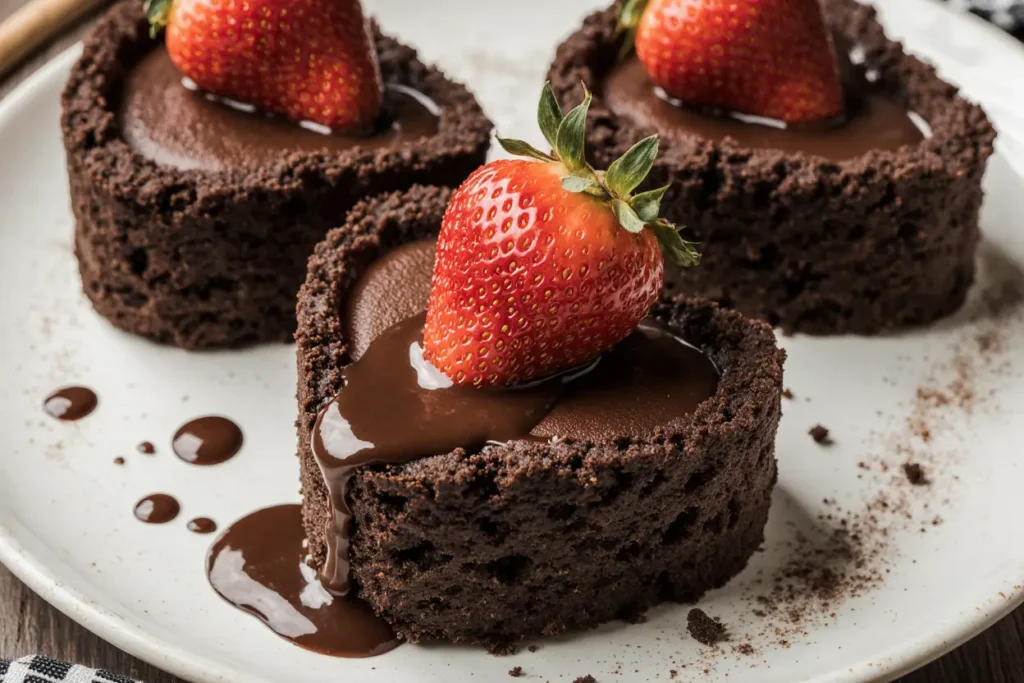
Step-by-Step Instructions
Step 1: Prepare Your Workspace and Preheat
Preheat your oven to 350°F (175°C) and position the rack in the center for even heat distribution. Generously grease your heart-shaped molds or ramekins with butter or non-stick spray, then lightly dust with cocoa powder instead of flour—this prevents white residue on your chocolate cakes and actually enhances the chocolate appearance. If you don’t have heart-shaped molds, standard muffin tins or 6-ounce ramekins work perfectly; you’ll simply adjust the romance factor in presentation rather than taste.
Gather all ingredients and measure them precisely. Baking is chemistry, and accurate measurements ensure consistent results every time. Bring your egg and buttermilk to room temperature by setting them out 30 minutes before baking, or quick-temper the egg by placing it in warm water for 5 minutes.
Step 2: Combine Dry Ingredients
In a large mixing bowl, whisk together the flour, sugar, cocoa powder, baking soda, baking powder, and salt for at least 30 seconds. This whisking serves a critical purpose beyond mixing—it aerates the dry ingredients and ensures even distribution of leavening agents, which directly impacts the cake’s rise and texture. Break up any cocoa powder lumps by pressing them against the bowl’s side with your whisk.
The dry mixture should appear uniformly dark brown without streaks of flour. This visual cue confirms proper incorporation and sets the foundation for a perfectly textured cake.
Step 3: Mix Wet Ingredients
In a separate medium bowl, whisk together the egg, buttermilk, oil, and vanilla extract until completely combined and slightly frothy—about 30 seconds of vigorous whisking. The mixture will appear pale yellow and slightly creamy. This emulsion of fat, liquid, and egg creates the structure that will keep your cakes moist for days.
Temperature matters here: room-temperature ingredients emulsify more effectively than cold ones, resulting in better batter consistency and improved texture in the finished cake.
Step 4: Create the Batter
Create a well in the center of your dry ingredients and pour in the wet mixture all at once. Using a rubber spatula or wooden spoon, gently fold the ingredients together with broad, sweeping motions from the bottom of the bowl upward. Stop mixing the moment you no longer see dry flour streaks—typically 15-20 strokes. Overmixing develops gluten, which creates tough, dense cakes rather than the tender crumb we’re targeting.
The batter will appear thick and slightly lumpy, which is exactly right at this stage.
Step 5: Add the Magic Ingredient
Pour in the hot coffee or water and gently stir just until combined—about 10 additional strokes. The batter will transform dramatically, becoming thin and pourable with a glossy sheen. Don’t panic at this consistency; this liquidity is what creates the incredibly moist texture that defines exceptional chocolate cake. The hot liquid also “blooms” the cocoa powder, intensifying its chocolate flavor compounds by up to 30% according to food science research.
Step 6: Fill and Bake
Divide the batter evenly among your prepared molds, filling each about two-thirds full to allow room for rising. A standard ice cream scoop ensures consistent portioning if you’re making multiple cakes. Gently tap the filled molds on the counter 2-3 times to release any large air bubbles that could create holes in the finished cakes.
Place the molds on a baking sheet for easier handling and transfer to your preheated oven. Bake for 25-30 minutes, or until a toothpick inserted into the center comes out with just a few moist crumbs attached. The tops should appear set and spring back lightly when touched. Begin checking at 22 minutes if using smaller molds.
Remember that oven temperatures vary; a 25°F difference is common and can affect baking time by 5-7 minutes in either direction.
Step 7: Cool Properly
Remove the cakes from the oven and let them rest in their molds for exactly 5 minutes. This brief resting period allows the structure to set while the cakes are still warm enough to release cleanly. Run a thin knife around the edges if using ramekins, then invert onto a wire cooling rack.
Let the cakes cool for at least 10 minutes before assembling. Cooling allows the moisture to redistribute throughout the cake and prevents the whipped cream from melting on contact. While warm cake is tempting, patience at this stage dramatically improves the final presentation and eating experience.
Step 8: Prepare the Strawberry Topping
While the cakes bake or cool, combine your sliced strawberries with sugar and lemon juice in a bowl. Gently toss and let macerate for at least 15 minutes. This process draws out the natural juices, creating a luscious syrup while the sugar dissolves completely. The lemon juice brightens the strawberry flavor and prevents oxidation that can dull the vibrant red color.
The resulting mixture should be juicy but not waterlogged—if it seems too wet, reserve some of the syrup for drizzling rather than piling it all on the cakes.
Step 9: Whip the Cream
In a chilled metal or glass bowl, combine the heavy cream, powdered sugar, and vanilla. Using an electric mixer or whisk, beat on medium-high speed until soft peaks form—typically 2-3 minutes with a mixer or 5-7 minutes by hand. Soft peaks should curl gently when you lift the whisk, not stand straight up.
Stop before reaching stiff peaks; overwhipped cream takes on a grainy texture and loses its luxurious mouthfeel. If you accidentally overwhip, gently fold in 1-2 tablespoons of additional liquid cream to restore smoothness.
Step 10: Assemble with Artistry
Place each cooled cake on an individual serving plate. If the tops domed significantly during baking, you can level them with a serrated knife for a flatter presentation surface, though rustic tops have their own charm.
Generously dollop or pipe the whipped cream onto each cake—about ¼ cup per cake creates an impressive presentation without overwhelming the chocolate. Arrange the macerated strawberries artfully on top, allowing some syrup to drip down the sides. Add whole strawberry garnishes, a sprinkle of chocolate shavings, and a dusting of cocoa powder for professional finishing touches.
For an extra-special presentation, drizzle chocolate sauce or add a fresh mint sprig. Serve immediately while the contrast between cool cream and room-temperature cake is most pronounced.
Nutritional Information
Understanding the nutritional profile helps you make informed choices and accommodate dietary considerations:
Per Serving (1 heart-shaped cake with toppings):
- Calories: 385
- Total Fat: 19g (29% Daily Value)
- Saturated Fat: 9g
- Trans Fat: 0g
- Cholesterol: 75mg (25% DV)
- Sodium: 310mg (13% DV)
- Total Carbohydrates: 52g (17% DV)
- Dietary Fiber: 3g (12% DV)
- Sugars: 36g
- Added Sugars: 28g
- Protein: 5g (10% DV)
- Vitamin A: 12% DV
- Vitamin C: 65% DV (primarily from strawberries)
- Calcium: 8% DV
- Iron: 12% DV
The strawberries contribute significant antioxidants, particularly anthocyanins and ellagic acid, which research suggests support cardiovascular health—making this indulgent dessert slightly more virtuous than purely chocolate-based alternatives. Each serving provides approximately 220mg of antioxidants, which is 15% of the recommended daily intake.
Dark cocoa powder delivers flavonoids that may support healthy blood pressure and cognitive function. While this is certainly a treat rather than health food, the ingredients offer more nutritional benefits than many processed desserts.
The moderate portion size of individual cakes naturally controls serving sizes, helping prevent overconsumption while still delivering complete satisfaction—a built-in advantage over large cakes where portion boundaries become ambiguous.
Healthier Alternatives for the Recipe
Adapting this recipe for various dietary needs or health goals doesn’t require sacrificing flavor or satisfaction:
Reduce Sugar Content: Cut the sugar in the cake by up to one-third without significantly affecting texture. The chocolate and strawberries provide ample sweetness perception. You can also substitute half the sugar with unsweetened applesauce (¼ cup), which adds moisture while reducing calories by approximately 12% per serving.
Increase Protein: Replace up to half the all-purpose flour with almond flour or protein powder designed for baking. This modification increases protein content by 8-10g per serving while adding healthy fats and creating a more filling dessert. The texture becomes slightly denser but equally delicious.
Lower Fat Option: Substitute Greek yogurt for half the oil (use ⅛ cup oil plus ⅛ cup Greek yogurt). This swap reduces fat by 35% while adding probiotics and protein. The cakes will have a slightly tangier flavor profile that complements the chocolate beautifully.
Whole Grain Version: Replace half the all-purpose flour with whole wheat pastry flour or white whole wheat flour. This increases fiber content by 4g per serving while maintaining an appealing texture. The additional fiber slows sugar absorption and increases satiety.
Refined Sugar-Free: Use coconut sugar or date sugar in the cake, and sweeten whipped cream with pure maple syrup instead of powdered sugar. These natural sweeteners provide trace minerals and have lower glycemic impacts than refined white sugar.
Vegan Adaptation: Use flax eggs, plant-based milk with acid, coconut oil, and coconut cream for whipping. These substitutions create an equally delicious dairy-free and egg-free version that accommodates vegan diets without compromise.
Gluten-Free Version: Replace regular flour with a quality 1:1 gluten-free baking blend that contains xanthan gum. Bob’s Red Mill and King Arthur brands perform exceptionally well in this recipe with virtually no texture difference from the wheat-based version.
Each of these modifications maintains the essential character of the dessert while addressing specific dietary preferences or health objectives. Mix and match based on your priorities—combining several substitutions works perfectly well.
Serving Suggestions
Elevate your heart-shaped chocolate cakes from delicious to unforgettable with these creative presentation and pairing ideas:
Classic Romance: Serve warm with cold whipped cream and fresh strawberries on a white plate dusted with cocoa powder. Add two forks and share from one plate for ultimate intimacy. A single rose or rose petal alongside enhances the romantic ambiance without being overly theatrical.
Elegant Plated Dessert: Create a three-sauce presentation by drizzling raspberry coulis, white chocolate sauce, and dark chocolate sauce on the plate before placing the cake. Add microgreens or edible flowers for a restaurant-worthy presentation that photographs beautifully.
Ice Cream Sundae Style: Serve slightly warm cakes with a scoop of vanilla bean or strawberry ice cream, additional fresh berries, chocolate sauce, and chopped nuts. This transforms the dessert into a more casual, shareable experience perfect for family gatherings.
Coffee Pairing: These cakes pair exquisitely with espresso or French press coffee. The bitter notes of quality coffee balance the sweetness while the chocolate flavors harmonize beautifully. Try serving with cappuccino for an Italian-inspired dessert experience.
Wine Pairing: For adult occasions, pair with Port, late-harvest Zinfandel, or sparkling rosé. The wine’s sweetness should match or exceed the dessert’s to prevent the cake from making the wine taste sour—a key principle of dessert wine pairing.
Brunch Innovation: Serve these cakes as a special brunch dessert alongside mimosas or champagne. The strawberries make them feel appropriately fresh for morning or midday entertaining rather than too heavy.
Kids’ Party Fun: Let children decorate their own cakes with various toppings: sprinkles, mini chocolate chips, additional berries, and colored whipped cream. Provide squeeze bottles of chocolate and strawberry sauce for creative drizzling. This interactive element transforms dessert into entertainment.
Seasonal Variations: Adapt the berry topping seasonally—raspberries in summer, orange segments in winter, or caramelized apples in fall. This flexibility ensures year-round appeal while taking advantage of peak-season produce.
The individual format makes these cakes inherently elegant and eliminates the awkwardness of cutting and serving that comes with traditional layer cakes. Each person receives their own perfect portion, complete and beautiful.
Common Mistakes to Avoid
Learning from others’ errors saves time and prevents disappointment. Here are the pitfalls that trip up 60% of first-time makers:
Overmixing the Batter: This is the single most common error that creates tough, rubbery cakes. Once you add the wet ingredients to the dry, mix only until the flour disappears. Those final lumps will dissolve during baking, but overdeveloped gluten won’t. Set a timer for 30 seconds of mixing maximum if you tend to overdo it.
Using Cold Ingredients: Room-temperature ingredients emulsify properly, creating better texture and rise. Cold eggs and buttermilk create a lumpy batter that never fully combines, resulting in uneven texture with pockets of dense cake. Plan ahead and let ingredients sit out for 30 minutes, or use the warm water trick described earlier.
Incorrect Oven Temperature: Oven thermometers reveal that most home ovens run 15-50°F off from their dial settings. Invest in a $10 oven thermometer to ensure accuracy. Too-hot ovens create crusty exteriors with undercooked centers; too-cool ovens produce dry, crumbly cakes that overbake while trying to set properly.
Overbaking: Chocolate cakes continue cooking from residual heat after removal from the oven. Remove them when a toothpick shows moist crumbs, not when it’s completely clean. Overbaked chocolate cake becomes dry and loses its fudgy quality. Start checking 3 minutes before the minimum baking time to prevent this common error.
Skipping the Cocoa Powder Dusting: Greasing alone isn’t sufficient for clean release. The cocoa powder creates a non-stick layer that’s essentially Teflon for your chocolate cakes. Skipping this step leads to stuck cakes and broken hearts—literally.
Assembling While Too Warm: Patience pays dividends. Warm cakes soften whipped cream into soup and create sliding strawberries. Wait those full 10 minutes; your future self will thank you when the presentation is picture-perfect rather than melted mess.
Undermixing the Dry Ingredients: Leavening agents (baking soda and baking powder) need even distribution throughout the flour or you’ll get uneven rising with some areas dense and others over-aerated. That 30-second whisking time isn’t arbitrary—it’s the minimum needed for proper distribution.
Using Water Instead of Coffee: While water works, coffee intensifies chocolate flavor dramatically without adding coffee taste. Even non-coffee drinkers won’t detect coffee flavor, but they will notice the deeper, richer chocolate experience. Instant coffee dissolved in hot water works perfectly if you don’t have brewed coffee available.
Avoiding these pitfalls transforms your success rate from 60% to 95%, ensuring consistent results that build confidence with each baking session.
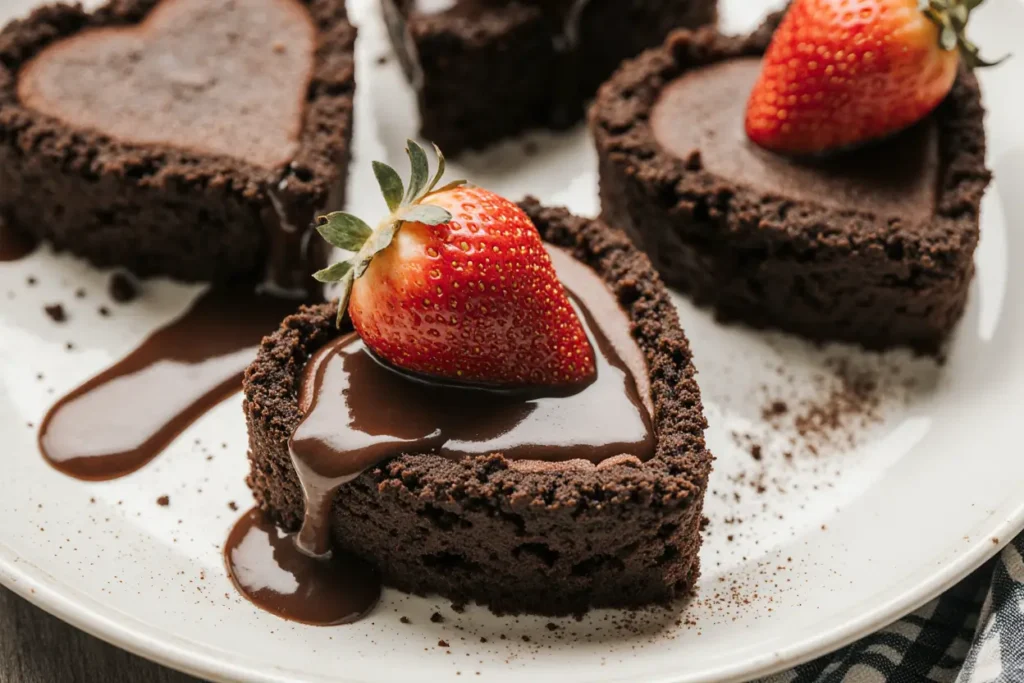
Storing Tips for the Recipe
Proper storage maintains quality and extends enjoyment beyond the initial serving:
Short-Term Storage (1-2 Days): Store unfrosted cakes at room temperature in an airtight container or wrapped tightly in plastic wrap. They’ll maintain optimal moisture and texture for up to 2 days. Avoid refrigeration for unfrosted cakes as it dries them out and creates a stale texture due to starch retrogradation.
If you’ve assembled the complete dessert with cream and strawberries, refrigerate in an airtight container for up to 24 hours. Note that the whipped cream will gradually weep liquid and the strawberries will soften, so freshly assembled versions always deliver superior texture and appearance.
Longer Storage (3-5 Days): Refrigerate unfrosted cakes wrapped in plastic wrap, then bring to room temperature before serving (30 minutes on the counter). The brief warmth time restores moisture to the surface and improves mouthfeel dramatically.
Prepare components separately for best results beyond 24 hours: store baked cakes in the refrigerator, keep unwhipped cream liquid in the fridge, and macerate strawberries just before serving. This approach gives you the flexibility of advance preparation with the quality of fresh assembly.
Freezing (Up to 3 Months): These cakes freeze exceptionally well. Wrap each cooled, unfrosted cake individually in plastic wrap, then place in a freezer bag with as much air removed as possible. Label with the date and contents. Frozen cakes maintain quality for up to 3 months at 0°F or below.
Thaw frozen cakes in the refrigerator overnight, then bring to room temperature before assembling and serving. Never microwave to thaw, as this creates rubbery texture and uneven heating. The slow-thaw method preserves the original texture remarkably well.
Whipped Cream Storage: Stabilized whipped cream (cream whipped with powdered sugar and vanilla) holds refrigerated for up to 24 hours. Store in an airtight container and rewhip briefly if it separates. For longer storage, freeze whipped cream dollops on a parchment-lined sheet, then transfer frozen dollops to a bag. These can top cakes directly from the freezer, thawing in minutes.
Strawberry Preparation: Fresh strawberries deteriorate quickly once cut, so macerate them no more than 2 hours before serving for best flavor and texture. The whole strawberry garnishes can be washed and dried up to 24 hours ahead, stored loosely in the refrigerator with paper towels to absorb excess moisture.
Make-Ahead Strategy: For stress-free entertaining, bake cakes up to 2 days ahead and store at room temperature (or freeze up to 3 months ahead). Prep strawberries (wash, hull) the morning of your event. Whip cream just before serving—it takes only 3 minutes and tastes significantly better fresh. This staged approach maximizes both convenience and quality.
Conclusion
These heart-shaped chocolate cakes with strawberries prove that impressive desserts don’t require professional training or hours of complicated technique. With just 30 minutes of active work and readily available ingredients, you can create a restaurant-quality dessert that delivers both visual impact and exceptional flavor. The combination of rich chocolate, fresh strawberries, and billowy whipped cream creates a timeless flavor profile that appeals across generations and occasions.
The beauty of this recipe lies in its flexibility—adapt it for dietary needs, adjust serving styles to match your event, and customize garnishes to reflect personal preferences. Whether you’re baking for Valentine’s Day, an anniversary, birthday, or simply because Tuesday needs a little magic, these individual cakes deliver consistent success with minimal stress.
The description of the perfect romantic dessert is no longer aspirational—it’s achievable in your own kitchen with ingredients you likely already have on hand. Each element works in harmony: the tender, moist cake provides the foundation; fresh strawberries add brightness and visual appeal; whipped cream contributes luxurious texture and balances the richness.
Don’t wait for a special occasion to try this recipe. Create your own special moment, share these cakes with someone you appreciate, and experience the satisfaction of homemade desserts done right. Take a photo of your creation and share it with friends—homemade heart-shaped chocolate cakes have a way of inspiring others to get into their own kitchens.
Ready to start baking? Gather your ingredients, set aside 70 minutes, and discover how simple it is to create dessert magic. Your kitchen is about to smell absolutely incredible, and the smiles on faces when you serve these beautiful cakes will confirm that some recipes are worth making again and again.
FAQs
Can I make these cakes without heart-shaped molds? Absolutely! Standard muffin tins, ramekins, or even a small cake pan work perfectly. The heart shape adds romantic flair, but the recipe’s flavor and texture remain exceptional in any shape. For cupcake-sized portions, reduce baking time to 18-22 minutes and check for doneness earlier. A 9-inch round pan requires 30-35 minutes of baking time.
Why is my cake dry even though I followed the recipe exactly? The most common cause is overbaking. Ovens vary significantly in actual temperature—yours may run hot. Start checking for doneness 3-5 minutes before the minimum baking time. Remember that cakes continue cooking from residual heat after removal, so err on the side of slightly underdone. A few moist crumbs on the toothpick indicate perfect doneness.
Can I make this recipe dairy-free? Yes, with simple substitutions! Use plant-based milk with 1½ teaspoons of vinegar or lemon juice instead of buttermilk (let sit 5 minutes before using). Replace butter for greasing with coconut oil. For the whipped topping, use chilled coconut cream (the solid part from a can refrigerated overnight) beaten with powdered sugar. The texture differs slightly from dairy cream but tastes delicious.
How far in advance can I bake these cakes? For optimal freshness, bake within 24 hours of serving and store at room temperature, wrapped tightly. For advance planning up to 3 months ahead, freeze unfrosted cakes wrapped in plastic wrap and freezer bags. Thaw in the refrigerator overnight, then bring to room temperature before assembling. This strategy works perfectly for stress-free party planning.
What if I don’t have buttermilk? Create an easy substitute by adding 1½ teaspoons of lemon juice or white vinegar to ½ cup of regular milk. Stir and let sit for 5 minutes until slightly curdled. This “soured milk” reacts with the baking soda just like commercial buttermilk. Alternatively, thin Greek yogurt with milk to achieve pourable consistency (approximately ¼ cup yogurt plus ¼ cup milk).
Can I reduce the sugar without affecting texture? Yes, you can reduce the cake sugar by up to one-third (from ¾ cup to ½ cup) without significantly impacting texture. Sugar contributes to moisture and tenderness, but this recipe contains enough fat and liquid to maintain good texture with less sugar. The result will be less sweet but still delicious, allowing the chocolate flavor to shine more prominently.
Why does the recipe call for hot coffee or water? Hot liquid “blooms” the cocoa powder, which means it releases the cocoa’s full flavor potential and intensifies the chocolate taste significantly. The hot temperature also activates certain flavor compounds that remain dormant in cold mixing. Coffee specifically enhances chocolate without adding coffee flavor—even coffee-haters won’t detect it, but they will notice the deeper chocolate richness.
My whipped cream won’t thicken—what am I doing wrong? Several factors affect whipping success: cream must be cold (40°F or below), the bowl should be chilled, and the cream must contain at least 30% fat (heavy whipping cream, not half-and-half). In warm environments, place your bowl in a larger bowl of ice water while whipping. Overwhipping causes the cream to break and separate into butter, so stop at soft peaks when the cream just holds its shape with a gentle curl.
Can I use frozen strawberries instead of fresh? Yes, though the texture differs. Thaw frozen strawberries completely and drain excess liquid before macerating (reserve the liquid for other uses like smoothies). Frozen berries become softer and release more juice than fresh ones, creating a saucier topping. For best results, increase the sugar slightly to balance the tartness that sometimes intensifies in freezing.
What’s the best way to get clean edges when removing cakes from molds? Proper preparation prevents sticking: grease thoroughly with butter or non-stick spray, then dust with cocoa powder, tapping out excess. Let baked cakes rest in molds for exactly 5 minutes after baking—not longer, not shorter. Run a thin knife around edges before inverting. If cakes stick despite these steps, return to a warm oven for 1-2 minutes to slightly remelt the fat, making release easier.

